Download Testbed for Predicate Routing in DTN over MANET User Manual
Transcript
Testbed for Predicate Routing in
DTN over MANET
User Manual
Flavio Esposito and Gabriele Ferrari Aggradi
Boston University
Email: {flavio, gfa}@cs.bu.edu
September 11, 2008
Abstract
This guide describes how to rebuild a User-Mode-Linux (UML) based
testbed we have used to test our Predicate Routing for DTN over MANET [5].
Following these instructions a number of UML virtual machines can be
set up to emulate DTN-MANET nodes, connected by a simulated network
through ns-2 [19].
1
Installing Ubuntu on a Virtual Machine
The testbed has been installed on an Ubuntu Linux distribution. A user can
follow herein the instructions for installing the testbed even with a different operating system or a different Linux distribution given a virtual machine support. In
this case an image of Ubuntu has to be installed. The version we used is Ubuntu
7.10 (Gutsy Gibbon) and the image we mounted has been:
ubuntu-7.10-desktop-i386.iso
downloadable from [7].
Examples of virtual machines are VMware [17] or the free KVM [6] (that has
to be used with QEMU [3]); in particular, the management tool needed to run the
OS image with KVM is called virt-manager.
1
In any case, the user who wishes to use a virtual machine has to make sure
the network adaptor is configured to share the host’s internet connection (NAT1 ).
We found that both virtual machines work well except when we used VMware,
together with a Virtual Private Network (VPN) running; the NAT protocol was
conflicting with VPN.
We solved the problem bringing down the network interfaces associated with
the virtual machine vmnet8 and vmnet1, shutting down VMware, disconnecting
the VPN and starting again the virtual machine; then the VMware network configuration file needed to be run again; of course a user can reset manually the
network interfaces that need to be up again.
Notice also that whenever a change in the VMware network configuration
setting is done (for example from NAT to bridge), the virtual machine needs to be
rebooted and it does not do automatically.
If the user wish to use virt-manager to run ubuntu, here below are listed some
of the not intuitive instructions to create the virtual machine:
• Create a new virtual system and load the ISO image.
• We suggest to be safe in the space allocation or not to assign the storage
space in advance unless the user is confident about how much is needed for
the purpose of the experiments.
• Connect to host Network via virtual network if the host is disconnected,
connected via wireless or dynamically configured with NetworkManager or
via shared physical device if the host is statically connected to the wired
ethernet, to gain the ability to migrate the virtual system.
• Allocate properly the memory and the cpu to the virtual machine
• It is common to get error of unable complete install:
”the virDominCreateLinux() failed. QEMU quits during console startup.”
Sometimes this error can be solved just by pressing the finish button again,
some other time the user needs to add his username to the kvm group, log
off and log in again. To solve, execute:
sudo adduser [username] kvm
Alternatively, the user can create an image and the QEMU system call as follows:
1
The Network Address Translator protocol allows multiple nodes (in this case one node would
be the host machine and the other is the virtualized machine) to share a single internet (or local
network) IP address.
2
/path1/qemu -hda /path2/NameImage.img -m 256
for 256 Mbyte of RAM allocated to the virtualized system. If the user is not the
installer of QEMU, “path1” should be “/usr/bin/”.
2
The Testbed
The architecture of the Linux based testbed we used can be described with a
set containing the following components:
• User-Mode-Linux: to emulate more than one machine (node).
• The DTN Reference Implementation Code: so that every emulated node is
a DTN-node.
• A Mobile Ad-hoc NETwork (MANET) Routing Protocol Implementation,
necessary to run the routing protocol at MANET level.
• The network simulator ns-2 (ns-emulation version), useful to simulate the
mobility of both DTN and MANET nodes.
In Figure 1, four emulated nodes are configured to communicate with the host
machine. For each emulated node, we need two network interfaces: one to interconnect the hosts creating a control network, and the other one to interconnect
with the ns-2 simulator. The control network has been created to remotely control the application on the emulated nodes during a testbed execution. A Linux
software bridge with the IP address 10.0.1.254 connects all guest control network
interfaces to the host system and to each other.
The user who wishes to implement the set of elements described, has to make
a choice:
1. To download a pre-compiled kernel for User-Mode-Linux with a filesystem
configured to work with that kernel [9] or,
2. To compile the kernel from source and to create the filesystem following the
instructions in the sections below.
Even though the first choice seems the easiest one, the associated tree sources
of the kernel have to be configured to support the addition of external modules.
For example, for our DTN over MANET testbed, we had to install in addition the
kaodv module.
3
Figure 1: Proposed testbed: each emulated node shall have an AODV daemon
running; some of the emulated nodes will be DTN nodes running a DTN reference
implementation. A machine will host the ns-2 simulator for simulating wireless
connectivity and mobility of emulated nodes. A control network is also established to remotely control the application on the emulated nodes during scenario
execution.
4
Some references to a pre-compiled kernel with a filesystem that suits our needs
are: UML home page [2], VNUML website [13] and the Nagafix website [8].2
3
User Mode Linux
This section provides compiling instructions for the kernel when a user wish
to use the User Mode Linux virtualization. Moreover, how to install the necessary
kernel module needed is explained.
Before starting we report the definition of UML from [18]: User-Mode-Linux
(UML) is an extended Linux kernel that works as a guest virtual machine on a
Linux host machine. It is possible to assign a root filesystem and other physical
resources different from the host machine. Technically, UML is a port of Linux to
Linux. Linux has been ported to many different processors, including the ubiquitous x86, Sun’s SPARC, IBM and Motorola’s PowerPC, DEC’s (then Compaq’s
and HP’s) Alpha, and a variety of others. UML is a port of Linux in exactly the
same sense as these. The difference is that it is a port to the software interface
defined by Linux rather than the hardware interface defined by the processor and
the rest of the physical computer.
3.1
How To Compile the Kernel For UML
This section explains how to compile and configure the kernel for User Mode
Linux. We underline again that we considered compiling our own kernel because
we think is the better way to have full control on the testbed features. The first
thing to do is to get the latest version source of the kernel tree from the Linux
Kernel Archives [15]. Then follow the instructions:
Unpack the tree as root:
[root@host]# bunzip2 linux-<version>.tar.bz2
Configure the kernel for User Mode:
[root@host]#
[root@host]#
[root@host]#
[root@host]#
[root@host]#
[root@host]#
apt-get update
apt-get upgrade
apt-get install ncurses-dev
cd linux-<version>
make defconfig ARCH=um
make menuconfig ARCH=um
2
We do not guarantee that all of them have been compiled enabling the addition of new modules, such as kaodv.
5
The option “ARCH=um” is vitally important while building UML, since it causes
the kernel built to work as a separate Linux architecture.
In the rest of this section, the options that we used in our testbed are listed.
The user may need to enable or disable others in order to build a fully functioning kernel. We report the options that we have set after running the system call
menuconfig:
• Load module support → Enable: To add modules or external modules to
the kernel and to permit the automatic load.
• UML Specific Options → Host Processor Type Features → Generic x86
support → Disable
• UML Specific Options → Host Processor Type Features → Process Family
→ Choose your processor
• Networking → Amateur Radio → Disable
• Networking → IRDA (infrared) Subsystem Support → Disable
• Networking → Blue tooth Subsytem Support → Disable
• Enable the Block Layer → Block Devices → Virtual block devices → Enable
• Character devices → stderr console → Enable
• Character devices → virtual serial line → Enable
• Character devices → port channel support → Enable
• Character devices → pty channel support → Enable
• Character devices → tty channel support → Enable
• Character devices → xterm channel support → Enable
• File systems: To make the kernel build faster enable the filesystems that you
would need (ext3 was one of them).
• SCSI support → Disable
• Multi-device support (RAID and LVM) → Multiple devices driver support
(RAID and LVM) → Disable
6
• Memory Technology Devices (MID) → Memory Technology Device (MID)
support → Disable
• Kernel Hacking → Show timing information on printks → Enable
• Kernel Hacking → Kernel debugging → Enable
• Kernel Hacking → Compile the Kernel with Debug Info → Enable
• Netfilter Options: Networking → Networking Options → Network Packet
Filtering (replaces ipchains) → IP: Netfilter configuration.
You have to enable all the options to <M> to use the modularized features.
We suggest to follow the instructions in the original source [16]. If the
source is no longer available, we also report the same page at [4].
Beginning with kernel 2.6.20, the Netfilter kernel configuration was completely changed. It is split into “Core Netfilter Configuration” and “IP Netfilter Configuration”.
Netfilter configuration is needed to use some network modules in the kernel
as AODV in our use case.
At this stage, after having complete the previous setting, we suggest to backup
the .config file:
[root@host]# cp .config .config.bkp
Now we can start with the compilation of the kernel. To do so we use the command:
[root@host]# make ARCH=um
3.2
How to Install the Kernel Modules
The following two commands are needed to install the modules of the kernel
and also to install the external modules.
[root@host]# make modules ARCH=um
[root@host]# make modules_install ARCH=um
After these commands the modules will be loaded in the /lib/modules/<kernel version>
of the host system. At this point, the user shall copy this directory in the same
place in the guest file system, after having mounted it.
Notice that in the directory /lib/modules/, the user might have two different
kernel versions, one for the host (for example 2.6.22.14-generic) and one for the
emulated system (for example 2.6.26). The latter is the kernel version to use.
7
4
About the Filesystem
At the end of this section the software necessary for the testbed will be completed. A User Mode Linux instance requires a kernel and a root filesystem in
order to run. The filesystem is stored in a file on the host system. The UML kernel uses an user block device (ubd), mapped to this file, to access its root filesystem. The UML can also use the copy-on-write (COW) feature of the ubd driver to
share a single filesystem among a number of virtual machines: the root filesystem
in this case is used as a read-only file and all the writes are done on a separate
copy-on-write file for each virtual machine. The following subsections explain
how to install the AODV kernel module, the DTN reference implementation, and
finally how to create, mount and configure the filesystem.
4.1
Create the Filesystem
Among all the common distributions we used the Debian [12], following the
user mode linux tradition. To begin, the user shall initialize the files using the
system call dd. Assuming that the user image files are root fs in the directory
/home/<user>, in terminal as root we type:
[root@host]# dd if=/dev/zero of=/home/<user>/root_fs bs=
1024K count=1000
With the call above, we have created a filesystem of 1024 Mb. Of course the user
might need a different size. The next step is to initialize the filesystems inside of
each of these files. We will be using ext3 as our root filesystem. If the system does
not recognize root f s as a block special device, proceed anyway.
[root@host]# mkfs.ext3 /home/<user>/root_fs
Now the user needs to mount the root filesystem before calling debootstrap.
[root@host]# mkdir /mnt/uml
[root@host]# mount -o loop /home/<user>/root_fs /mnt/uml
Next step is to install debootstrap and bootstrap a base Debian installation. This is
a barebones installation that is less than 200 megabytes. We used the latest testing
distribution whose codename is lenny.
[root@host]# apt-get install debootstrap
[root@host]# debootstrap --arch i386 lenny /mnt/uml http://
ftp.us.debian.org/debian
8
4.2
Mount the filesystem
This section lists the commands the user needs to execute in the filesystem:
In terminal as root:
[root@host]#
[root@host]#
[root@host]#
[root@host]#
[root@host]#
[root@host]#
[root@host]#
cd /mnt
mkdir uml
cd uml
mkdir proc
mount -o loop /<path>/<filesystem> /mnt/uml
mount -t proc none /mnt/uml/proc
chroot /mnt/uml
At this stage the user has access to the filesystem as root and can use commands like:
apt-get update
apt-get upgrade
apt-get install <name_of_package>
For the sake of completeness, we report also how to unmount the filesystem:
In terminal as root
[root@host]# umount /mnt/uml/proc
[root@host]# umount /mnt/uml
4.3
Configure the Filesystem
In order to configure the filesystem the user needs to edit the following files in
order to have your system in a valid configuration as follows:
• /etc/fstab
• /etc/hostname
• /etc/hosts
• /etc/network/interfaces
• /etc/apt/sources.list
• /etc/securetty
• /etc/inittab
• /deb/ubd0
9
1. check if /etc/fstab contains
/dev/ubd0 / ext3 defaults 0 1
proc /proc proc defaults 0 0
2. check if /etc/hostname contains
<umluser>
it will be the name of the user who will start the emulated node of the testbed
3. check if /etc/hosts (or /etc/hosts.allow) contains
127.0.0.1 localhost
4. check if /etc/network/interfaces contains
auto lo
iface lo inet loopback
5. check if /etc/apt/sources.list contains
http://ftp.us.debian.org/debian
6. check if /etc/securetty contains
#echo "tty0" >> /etc/securetty
#echo "ttys/0" >> /etc/securetty
7. modify /etc/inittab like this:
1:2345:respawn:/sbin/getty 38400 tty0
#2:23:respawn:/sbin/getty 38400 tty2
#3:23:respawn:/sbin/getty 38400 tty3
#4:23:respawn:/sbin/getty 38400 tty4
#5:23:respawn:/sbin/getty 38400 tty5
#6:23:respawn:/sbin/getty 38400 tty6
10
8. Since the testbed uses a Debian distribution, every time an instance of the
Operating System is generated with UML, an user would need to enter login and password. To speed up the process of instantiating many nodes in
the testbed, and since there are no real security issues in the virtualization,
the user might consider an autologin funtionality. One package which provides the autologin is the package mingetty. After installing the package as
follows,
[root@host]# apt-get install mingetty
the user needs to modify /etc/inittab like this:
1:2345:respawn:/sbin/mingetty --autologin root tty0
#2:23:respawn:/sbin/getty 38400 tty2
#3:23:respawn:/sbin/getty 38400 tty3
#4:23:respawn:/sbin/getty 38400 tty4
#5:23:respawn:/sbin/getty 38400 tty5
#6:23:respawn:/sbin/getty 38400 tty6
4.4
How to Install the DTN Reference Implementation
At this stage, we need to install the DTN Reference Implementation code on
the root fs; to do so, the user shall mount the filesystem root fs and download the
latest reference code from the official website [14]. Then, the packages Tcl/Tk,
Xerces and BerkeleyDB need to be installed. Before doing that, in order to run
our convergence layer, the user may need also to install the perl packages:
[root@host]# apt-get install libdatetime-perl \
libdbi-perl libdbd-mysql-perl \
libclass-autouse-perl libmd5-perl libdigest-sha1-perl \
libhtml-template-perl libimage-size-perl libmime-lite-perl \
libmime-perl libcompress-zlib-perl libnet-dns-perl \
liburi-perl libhtml-tagset-perl libhtml-parser-perl \
libwww-perl libwww-perl libgd-gd2-perl \
libmailtools-perl libunicode-maputf8-perl libxml-simple-perl \
libio-stringy-perl libdigest-hmac-perl
And likewise for the optional modules:
[root@host]# apt-get install libgd-graph-perl \
libproc-process-perl librpc-xml-perl \
11
libsoap-lite-perl libxml-rss-perl libstring-crc32-perl \
libxml-atom-perl libmath-bigint-gmp-perl liburi-fetch-perl \
libcrypt-dh-perl perlmagick libclass-accessor-perl \
libclass-trigger-perl libclass-data-inheritable-perl libgnupg-interfa
libmail-gnupg-perl libtext-vcard-perl
During your installation, the user can ignore the warning:
Can not write log, openpty() failed (/dev/pts not mounted?)
[root@root_fs]#
[root@root_fs]#
[root@root_fs]#
[root@root_fs]#
[root@root_fs]#
[root@root_fs]#
[root@root_fs]#
[root@root_fs]#
[root@root_fs]#
[root@root_fs]#
[root@root_fs]#
[root@root_fs]#
[root@root_fs]#
apt-get install tcl8.4
apt-get install tcl8.4-dev
apt-get install libxerces28
apt-get install libxerces28-dev
apt-get install libdb4.5
apt-get install libdb4.5-dev
apt-get install libdb4.5++
apt-get install libdb4.5++-dev
apt-get install libdb4.5-tcl
cd dtn-<version>/
./configure
make
make install
From the version dtn-2.5.0, released in October 2007, the user can also use the
binary debian package for the stable release (etch), as well as the source files,
through the apt package management system. The user needs to add the following
lines to /etc/apt/sources.list:
deb http://www.dtnrg.org/debian etch contrib
deb-src http://www.dtnrg.org/debian etch contrib
and finally run:
[root@host]# apt-get install dtn
4.5
Install the AODV Kernel Module
The routing protocol is a kernel module that needs to run as a daemon during our emulation. We have implemented our predicate routing starting from the
AODV-UU implementation of University of Uppsala. In order to reproduce the
testbed, the first thing to do is therefore to install that module on the guest filesystem. The module can be found at [1].
12
After downloading, the user needs to modify the Makefile in the main directory and in the directory /lnx, in particular, the version of the kernel, the install
directory and the uninstall directory. The default options is the directory /lib/modules of the host, but we need it in the same directory of the guest since we are
running the kernel in the guest. After changing the makefile, the installation of
the AODV kernel module will run with:
[root@host]# make ARCH=um
[root@host]# make install ARCH=um
As a final stage of the testbed installation, since the installation of the kernel modules writes the AODV modules in the /lib/modules/ < kernel version > of the
host system, the user again shall copy this directory in the same place in the guest
filesystem.
5
Configuring the Testbed
Having created the testbed, i.e. having installed the kernel filesystem, let us
give instructions on how to configure the host machine. This section will explain
how to create the virtual network structures and how to connect these with the
network simulator (ns-2).
5.1
Create User and Group
We need to create a group to have access to the virtual network interface on
the host machine. To do so:
in the terminal as root:
[root@host]# groupadd <group_name>
Then we need to add the user to the group created previously.
This user will be able to use network emulation in ns-2 in the terminal as root:
[root@host]# useradd <user_name> -G <group_name>
5.2
Install NS2-Emulation on the Host
Since the node whose mobility is simulated by ns-2 are emulated, the modified
version of ns-2 (ns2emulation) shall be used.
Ns-2 acts like a bridge between the virtual Ethernet interfaces TAP. It reads
packets from a source TAP device, it passes them through a simulated wireless
network and it writes them back to the TAP device destination. Each ns-2 in the
13
simulated network represents an UML virtual machine in the real network. Even
in this case there are two ways to install ns-2 in the host machine with emulated
extension: the first one is to build it from the source, the second one is to use a
Debian package.
Here we used simply one of the two, the Debian package, downloading from the
website of the original project [11] and adding the following lines to the repositories list in /etc/apt/source.list:
deb http://bode.cs.uni-magdeburg.de/˜aherms/debian sid ns2
deb-src http://bode.cs.uni-magdeburg.de/˜aherms/debian sid ns2
to install from the new repository you have to update the packages list
in terminal as root, type:
[root@host]# apt-get update
[root@host]# apt-get install nsemulation
[root@host]# apt-get source nsemulation
The ns-2 emulation is made from network objects and tap agents.
The network objects are used to send and receive packets to and from a network.
The ns-2 network object at the link layer uses the pcap library to read packets
from a network device. The emulation version of ns-2 implements a new network
object to read and write packets to a network device at the link layer using the
Linux packet sockets for this purpose. The network object for link layer access is
called Network/Raw. It supports the commands open and close with the following
syntax:
<Network Object> open <Interface Name>
[readwrite | readonly | writeonly]
<Network Object> close
The user can use it for example in the following way:
set raw0 [new Network/Raw]
$raw0 open tap0 readwrite
[...]
$raw0 close
The tap agents are connected to network objects and to ns-2 nodes, obtaining
network packets from the network objects and sending them through the simulated network. In the emulation version of ns-2 the new tap agent is called
Agent/T ap/Raw. It implements additionally address mapping between MAC
addresses of the virtual machines and IP addresses of ns-2 nodes. Each Agent
is assigned to one virtual network interface via a network object Network/Raw.
14
The only difference in using Agent/T ap/Raw is that at the creation the user has
to specify the MAC address of the machine that the agent corresponds to. For
example:
set a0 [new Agent/Tap/Raw "FE:FD:0A:00:00:01"]
In this case the tap agent registers in a common mapping table that it is responsible for receiving frames with the specified MAC address. The tap agents
then use this mapping table to determine the destination network address within
the simulation.
To test the installation the user can use the example in [11] with the command
as normal user
[user@host]# nse ns2emulation.tcl
If launched at this stage, the script will generate an error since there are no tap
interfaces installed yet.
An exemplifying script is the following:
#! /bin/nse
# An example script for the usage of ns-2 in emulation mode:
# Uses:
# 1. Network/Raw agents to access to a network device at level II
# 2. Tap/Raw agents to map between real MAC addresses and
# NS-2 IP addresses
# 3. In-memory compression of the trace file to reduce disk write
# operations during simulation
#
# Common variables
set scriptname routingdemo
set val(chan)
Channel/WirelessChannel
set val(prop)
Propagation/TwoRayGround
set val(netif)
Phy/WirelessPhy
;
set val(mac)
Mac/802_11
;
set val(ifq)
Queue/DropTail/PriQueue
;
set val(ll)
LL
;
set val(ant)
Antenna/OmniAntenna
;
set val(ifqlen)
50
;
set val(x)
800
;
set val(y)
600
;
set val(rp) DumbAgent
;
set val(nn) 4
;
15
set val(stime) 180.0
;
#set val(stime) 360000.0
;
set val(sc)
"mobility.tcl"
set ns_ [new Simulator]
$ns_ use-scheduler RealTime
#use this for file trace
set tracefd [open "|gzip > $scriptname.tr.gz" w]
set namtrace [open "|gzip > $scriptname.nam.gz" w]
#use this to pipe the namtrace to nam (only do this in X)
set namtrace [open "|nam -r 0.1 -" w]
#use this to disable tracing
#set tracefd [open "/dev/null" w]
#set namtrace [open "/dev/null" w]
$ns_ trace-all $tracefd
$ns_ namtrace-all-wireless $namtrace $val(x) $val(y)
#set tr0 [new BaseTrace/ShmGZ test.tr.gz 16 400 104857600]
#Procedure needed when running nam in real-time
proc NamTime {} {
#Send time to nam periodically
global ns_ namtrace
set now [$ns_ now]
set next [expr $now + 0.05]
puts $namtrace "T -t $now"
flush $namtrace
$ns_ at $next "NamTime"
}
$ns_ at 1.0 "NamTime"
proc UniformErr {} {
set err [new ErrorModel]
$err unit packet
$err set rate_ 0.01
$err ranvar [new RandomVariable/Uniform]
16
$err drop-target [new Agent/Null]
return $err
}
set topo [new Topography]
$topo load_flatgrid $val(x) $val(y)
# Create GOD
set god_ [create-god $val(nn)]
# Create channel
set chan_1_ [new $val(chan)]
# Configure node parameters
$ns_ node-config -adhocRouting $val(rp) \
-llType $val(ll) \
-macType $val(mac) \
-ifqType $val(ifq) \
-ifqLen $val(ifqlen) \
-antType $val(ant) \
-propType $val(prop) \
-phyType $val(netif) \
-topoInstance $topo \
-agentTrace OFF \
-routerTrace OFF \
-macTrace ON \
-movementTrace OFF \
-channel $chan_1_ \
-IncomingErrProc UniformErr
#Procedure to configure an ns-2 node initially
#proc setup_node {id x y z color} {
#
# global ns node_
# set node_($id) [$ns_ node]
# $node_($id) set X_ $x
# $node_($id) set Y_ $y
# $node_($id) set Z_ $z
# $node_($id) color $color
# $ns_ at 0 "$node_($id) setdest $x $y 0"
17
# $ns_ at 0 "$node_($id) color $color"
# $node_($id) random-motion 0
#}
#setup_node
#setup_node
#setup_node
#setup_node
1
2
3
4
100
250
350
500
300
300
300
300
0
0
0
0
"black"
"green"
"blue"
"cyan"
for {set i 0} {$i <= 3} {incr i} {
global ns_ node_
set node_($i) [$ns_ node]
$node_($i) random-motion 0
$ns_ at 0 "$node_($i) start";
$ns_ at $val(stime) "$node_($i) reset";
}
$node_(0)
$node_(1)
$node_(2)
$node_(3)
#Network
set raw1
set raw2
set raw3
set raw4
$raw1
$raw2
$raw3
$raw4
color
color
color
color
black
green
blue
cyan
objects to access the TAP devices at the link layer
[new Network/Raw]
[new Network/Raw]
[new Network/Raw]
[new Network/Raw]
open
open
open
open
tap0
tap1
tap2
tap3
readwrite
readwrite
readwrite
readwrite
#Tap Agent for each node
Agent/Tap set maxpkt_ 3100
set a1 [new Agent/Tap/Raw "FE:FD:C0:A8:2F:01"]
set a2 [new Agent/Tap/Raw "FE:FD:C0:A8:2F:02"]
set a3 [new Agent/Tap/Raw "FE:FD:C0:A8:2F:03"]
set a4 [new Agent/Tap/Raw "FE:FD:C0:A8:2F:04"]
puts "install nets into taps..."
18
#Assign network objects to TAP agents
$a1 network $raw1
$a2 network $raw2
$a3 network $raw3
$a4 network $raw4
#Assign TAP agents to ns-2 nodes
$ns_ attach-agent $node_(0) $a1
$ns_ attach-agent $node_(1) $a2
$ns_ attach-agent $node_(2) $a3
$ns_ attach-agent $node_(3) $a4
puts "loading scenario..."
source $val(sc)
puts "scenario loaded!!!"
$ns_ at $val(stime) "stop"
$ns_ at $val(stime) "puts \"NS EXITING ...\" ; $ns_ halt"
proc stop {} {
global ns_ tracefd raw1 raw2 raw3 raw4
$ns_ flush-trace
close $tracefd
$raw1 close
$raw2 close
$raw3 close
$raw4 close
}
puts "okey"
$ns_ run
5.3
Create the Virtual Tnterface tap<X>
One of the possible transport mechanisms for User Mode Linux is the TAP
virtual Ethernet device. To use the TAP devices the TUN/TAP driver should be
included in the kernel configuration. If the kernel does not have this option one
can download a patch from the TUN/TAP home page [10]. The user needs also
the tunctl tool which is used to configure TUN/TAP devices. This is included in
19
the uml − utilities package in the Debian-based system:
[root@host]# apt-get install uml-utilities
Now we can set up TAP devices for User Mode Linux machines and prepare
them for the network emulation. If the device /dev/net/tun does not exist, create
it in terminal as root:
[root@host]# mkdir /dev/net
[root@host]# mknod /dev/net/tun c 10 200
Create the permissions to read/write for the group created previously:
In terminal as root:
[root@host]# chown :tun /dev/net/tun
[root@host]# chmod g+rw /dev/net/tun
The general command to create a virtual interface is:
[root@host]# tunctl -b -u <user_name> -t tap<X>
and to destroy a virtual interface is:
[root@host]# tunctl -d tap<X>
5.4
Create the Bridge
A network bridge is needed to create a control network to control the nodes
during the test by a ssh session.
In terminal as root, type:
[root@host]# ./bridge_up
this script is:
#!/bin/bash
#
brctl addbr br0
brctl stp br0 off
brctl addif br0 tap4
brctl addif br0 tap5
brctl addif br0 tap6
brctl addif br0 tap7
ifconfig br0 10.0.1.254 netmask 255.255.255.0 up
20
with this netmask configuration, the control network will be 10.0.1.x
To destroy the bridge at the end of the test:
in terminal as root
[root@host]# ./bridge_down
this script is:
#!/bin/bash
#
ifconfig br0 down
brctl delbr br0
6
How to Run the Testbed
Having installed and configured the testbed, we can finally play with it. This
section describes the scripts needed to run it. First of all, we need to initialize the
machine in terminal as root:
[root@host]# ./init
The script contains the following instructions:
#!/bin/bash
#script init
#
groupadd tun
useradd ubuntu -G tun
chown :tun /dev/net/tun
chmod g+rw /dev/net/tun
Then, we need to start the virtual interface tap<X> as many as the number of
nodes in the emulation.
Calling the following script as root:
[root@host]# ./tap_up <numbers_of_nodes>
which exactly does (for seven interfaces):
#!/bin/bash
#
tunctl -u ubuntu -t tap0 -b
ifconfig tap0 up
tunctl -u ubuntu -t tap1 -b
21
ifconfig tap1 up
tunctl -u ubuntu
ifconfig tap2 up
tunctl -u ubuntu
ifconfig tap3 up
tunctl -u ubuntu
ifconfig tap4 up
tunctl -u ubuntu
ifconfig tap5 up
tunctl -u ubuntu
ifconfig tap6 up
tunctl -u ubuntu
ifconfig tap7 up
-t tap2 -b
-t tap3 -b
-t tap4 -b
-t tap5 -b
-t tap6 -b
-t tap7 -b
In order to start more than one terminal for each emulated node with command
as user (for example for the first emulated machine with number 1) the following
command shall be used:
[user@host]# ./node <number_of_nodes>
Where node is the following script:
#!/bin/bash
#
echo " "
echo "node "${1}" starting..."
echo " "
A=$[${1}-1]
B=$[A+4]
xterm -T node${1} -e ./linux ubd0=cow_uml$A,
root_fs eth0=tuntap,tap$A eth1=tuntap,tap$B &
Notice that the command cow umlX makes a local copy of the general filesystem
root fs
6.1
Configuring Emulated Nodes
In order to configure the emulated nodes, in each virtual machine UML the
user shall execute the following commands:
[root@vm]# ./init_node <number_of_node>
this script is (the MAC address must be the same as in the ns2emulation.tcl configuration file):
22
#!/bin/bash
#
echo "configure node "${1}
hostname node${1}
ifconfig eth0 10.0.0.${1}
netmask 255.255.255.0 hw ether FE:FD:C0:A8:2F:0${1} up
ifconfig eth1 10.0.1.${1} netmask 255.255.255.0 up
echo "node "${1}" configured"
At this stage, we need to initialize the AODV kernel module and to run the
AODV daemon:
[root@vm]# ./aodv
this script is:
#!/bin/bash
#
modprobe kaodv
aodvd -d -i eth0 -l -r 3
Where the option -d means that it will run in daemon mode;
the option -i eth0 means that the interface eth0 will be used;
the option -l enables the logging in the file /var/log/aodv.log;
the option -r 3 enables the logging every 3 seconds of the routing table in the file
/var/log/aodv.rtlog.
We also need to initialize the database of the DTN node and we do so calling:
[root@vm]# ./init_dtn
This script is:
#!/bin/bash
#
dtnd --init-db
To run the DTN daemon for running the node as a DTN node:
[root@vm]# ./dtn
and this script is:
#!/bin/bash
#
dtnd -d -o /var/log/dtn.log -t
23
where the option -d means that it will run in daemon mode;
the option -o /var/log/dtn.log means that the log file will be in /var/log/dtn.log
(option needed if you use the option -d)
and the option -t clears the database and initializes the tables on startup. We are
now ready to run the ns2 simulations on the testbed having only the AODV routing
protocol.
24
References
[1] AODV Module. Uppsala University, Sweden. http://core.it.uu.
se/core/index.php/AODV-UU.
[2] http://user-mode-linux.sf.net/.
[3] http://bellard.org/qemu.
[4] http://cs-people.bu.edu/flavio/
kernelConfiguration4Testbed.htm.
[5] http://csr.bu.edu/preda/.
[6] http://kvm.qumranet.com/kvmwiki/HOWTO1.
[7] http://releases.ubuntu.com/7.10/.
[8] http://uml.nagafix.co.uk/.
[9] http://user-mode-linux.sourceforge.net/.
[10] http://vtun.sourceforge.net/tun/.
[11] http://www-ivs.cs.uni-magdeburg.de/EuK/forschung/
projekte/nse/.
[12] http://www.debian.org/.
[13] http://www.dit.upm.es/vnumlwiki/index.php/Main_
Page.
[14] http://www.dtnrg.org/wiki/Code.
[15] http://www.kernel.org/.
[16] http://www.shorewall.net/kernel.htm.
[17] http://www.vmaware.com.
[18] Jef Dike. User Mode Linux. Bruce Perens’ Open Source Series. Prentice
Hall, 2006.
[19] Daniel Mahrenholz and Svilen Ivanov. Real-time network emulation with
ns-2. In In Proc. of DS-RT, pages 29–36, 2004.
25

























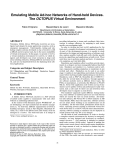
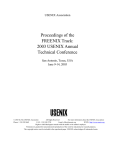

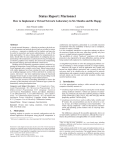
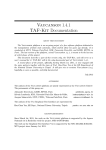
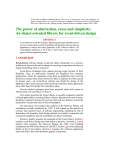
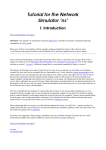
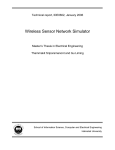
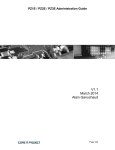

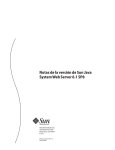

![[GLPI & OCS Inventory]](http://vs1.manualzilla.com/store/data/006327452_1-4f96a94df8ab4a789ff4fc22a306587e-150x150.png)